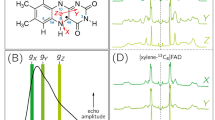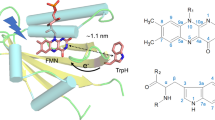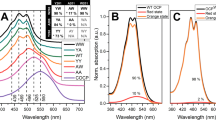Abstract
Spectroscopic studies have provided extensive information on the primary process of visual pigments and photoexcitation of chlorophyll as well as their effects on the surrounding polypeptide chain, but a dependence of photoreactivity on the higher-order structures of protein has been observed only rarely. Resonance Raman spectroscopy can reveal the vibrational frequencies of the chromophore in a molecule provided the excitation wavelength is in the absorption band of that molecule. As the visible absorption bands of haemproteins are due to ππ* transitions of the porphyrin ring, we can selectively observe the vibrational frequencies of iron porphyrin during in situ interactions with immediate amino acid residues of protein when the wavelength of excitation light is close to the Soret or Q band. Correlation of some vibrational frequencies of haem with the oxidation and spin states of the haem iron has been studied in detail and an empirical rule has been established1,2. This method is therefore especially suitable for the study of an effect of higher-order structures of protein on the chromophore. We report here a photoreaction facilitated by a particular quaternary structure of protein—in various haemoglobins resonance Raman spectroscopy showed that reversible photoreduction of haem took place in the T state but not the R state.
This is a preview of subscription content, access via your institution
Access options
Subscribe to this journal
Receive 51 print issues and online access
$199.00 per year
only $3.90 per issue
Buy this article
- Purchase on Springer Link
- Instant access to full article PDF
Prices may be subject to local taxes which are calculated during checkout
Similar content being viewed by others
References
Spiro, T. G. Biochim. biophys. Acta 416, 169–187 (1975).
Kitagawa, T., Ozaki, Y. & Kyogoku, Y. Adv. Biophys. 11, 153–196 (1978).
Gibson, Q. H. Biochem. J. 71, 193–194 (1959).
Perutz, M. F. Nature 228, 726–734 (1970).
Nagai, K., Kitagawa, T. & Morimoto, H. J. molec. Biol. (in the press).
Perutz, M. F. et al. Biochemistry 17, 3640–3652 (1978).
Kitagawa, T., Kyogoku, Y., Iizuka, T. & Ikeda-Saito, M. J. Am. chem. Soc. 98, 5169–5173 (1976).
Cheung, L. D., Yu, N.-T. & Felton, R. H. Chem. phys. Lett. 55, 527–530 (1978).
Adar, F. & Yonetani, T. Biochim. biophys. Acta 502, 80–86 (1978).
Kitagawa, T. & Orii, Y. J. Biochem. (Tokyo) 84, 1245–1252 (1978).
Salmeen, I., Rimai, L. & Babcock, G. T. Biochemistry 17, 800–806 (1978).
Kilmartin, J. V. & Rossi-Bernardi, L. Biochem. J. 124, 31–45 (1971).
Tan, A. L., De Young, A., & Noble, R. W. J. biol. Chem. 247, 2493–2498 (1972).
Author information
Authors and Affiliations
Rights and permissions
About this article
Cite this article
Kitagawa, T., Nagai, K. Quaternary structure-induced photoreduction of haem of haemoglobin. Nature 281, 503–504 (1979). https://doi.org/10.1038/281503a0
Received:
Accepted:
Issue Date:
DOI: https://doi.org/10.1038/281503a0
This article is cited by
-
Resonance Raman studies of metalloporphyrins
Proceedings / Indian Academy of Sciences (1990)
-
Study of haem structure of photo-deligated haemoglobin by picosecond resonance Raman spectra
Nature (1980)
-
Raman difference spectroscopy of tertiary and quaternary structure changes in methaemoglobins
Nature (1980)
Comments
By submitting a comment you agree to abide by our Terms and Community Guidelines. If you find something abusive or that does not comply with our terms or guidelines please flag it as inappropriate.



